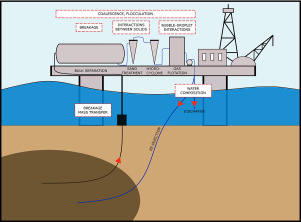当前位置:
X-MOL 学术
›
Adv. Colloid Interface Sci.
›
论文详情
Our official English website, www.x-mol.net, welcomes your feedback! (Note: you will need to create a separate account there.)
Colloid chemistry and experimental techniques for understanding fundamental behaviour of produced water in oil and gas production.
Advances in Colloid and Interface Science ( IF 15.6 ) Pub Date : 2020-01-10 , DOI: 10.1016/j.cis.2020.102105 Marcin Dudek 1 , Eilen Arctander Vik 2 , Svein Viggo Aanesen 3 , Gisle Øye 1
Advances in Colloid and Interface Science ( IF 15.6 ) Pub Date : 2020-01-10 , DOI: 10.1016/j.cis.2020.102105 Marcin Dudek 1 , Eilen Arctander Vik 2 , Svein Viggo Aanesen 3 , Gisle Øye 1
Affiliation

|
Due to increasing volumes of produced water and environmental concerns related to its discharge, water treatment has become a major challenge during the production of crude oil and natural gas. With continuously stricter regulations for discharging produced water to sea, the operators are obliged to look for ways to improve the treatment processes or re-use the water in a beneficial way, for example as a pressure support during oil recovery (produced water re-injection). To improve the knowledge of the underlying phenomena governing separation processes, detailed information of the composition and interfacial properties of produced water is undoubtedly useful and could provide valuable input for better understanding and improving separation models. This review article summarizes knowledge gained about produced water composition and the most common treatment technologies, which are later used to describe the fundamental phenomena occurring during separation. These colloidal interactions, such as coalescence of oil droplets, bubble-droplet attachment or partitioning of components between oil and water, are of crucial importance for the performance of various technologies and are sometimes overlooked in physical considerations of produced water treatment. The last part of the review deals with the experimental methodologies that are available to study these phenomena, provide data for models and support development of more efficient separation processes.
中文翻译:

胶体化学和实验技术,用于理解石油和天然气生产中采出水的基本行为。
由于采出水量的增加以及与排放有关的环境问题,水处理已成为生产原油和天然气的主要挑战。随着不断严格的法规将采出水排入海中,操作人员不得不寻找改善处理工艺或以有益方式再利用水的方法,例如在采油过程中作为压力支持(回注采出水) )。为了提高对控制分离过程的潜在现象的了解,毫无疑问,有关采出水的组成和界面特性的详细信息将很有用,并可为更好地理解和改进分离模型提供有价值的信息。这篇综述文章总结了有关产出水成分和最常用的处理技术的知识,这些知识后来被用来描述分离过程中发生的基本现象。这些胶体相互作用,例如油滴的聚结,气泡-液滴的附着或油与水之间的组分分配,对于各种技术的性能至关重要,有时在采出水处理的物理考虑中被忽略。审查的最后一部分讨论了可用于研究这些现象,为模型提供数据并支持开发更有效分离过程的实验方法。诸如油滴的聚结,气泡滴的附着或油与水之间的组分分配等对于各种技术的性能至关重要,有时在采出水处理的物理考虑中有时被忽略。审查的最后一部分讨论了可用于研究这些现象,为模型提供数据并支持开发更有效分离过程的实验方法。诸如油滴的聚结,气泡滴的附着或油与水之间的组分分配等对于各种技术的性能至关重要,有时在采出水处理的物理考虑中有时被忽略。审查的最后一部分讨论了可用于研究这些现象,为模型提供数据并支持开发更有效分离过程的实验方法。
更新日期:2020-01-11
中文翻译:

胶体化学和实验技术,用于理解石油和天然气生产中采出水的基本行为。
由于采出水量的增加以及与排放有关的环境问题,水处理已成为生产原油和天然气的主要挑战。随着不断严格的法规将采出水排入海中,操作人员不得不寻找改善处理工艺或以有益方式再利用水的方法,例如在采油过程中作为压力支持(回注采出水) )。为了提高对控制分离过程的潜在现象的了解,毫无疑问,有关采出水的组成和界面特性的详细信息将很有用,并可为更好地理解和改进分离模型提供有价值的信息。这篇综述文章总结了有关产出水成分和最常用的处理技术的知识,这些知识后来被用来描述分离过程中发生的基本现象。这些胶体相互作用,例如油滴的聚结,气泡-液滴的附着或油与水之间的组分分配,对于各种技术的性能至关重要,有时在采出水处理的物理考虑中被忽略。审查的最后一部分讨论了可用于研究这些现象,为模型提供数据并支持开发更有效分离过程的实验方法。诸如油滴的聚结,气泡滴的附着或油与水之间的组分分配等对于各种技术的性能至关重要,有时在采出水处理的物理考虑中有时被忽略。审查的最后一部分讨论了可用于研究这些现象,为模型提供数据并支持开发更有效分离过程的实验方法。诸如油滴的聚结,气泡滴的附着或油与水之间的组分分配等对于各种技术的性能至关重要,有时在采出水处理的物理考虑中有时被忽略。审查的最后一部分讨论了可用于研究这些现象,为模型提供数据并支持开发更有效分离过程的实验方法。



























 京公网安备 11010802027423号
京公网安备 11010802027423号